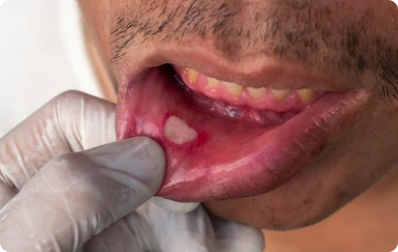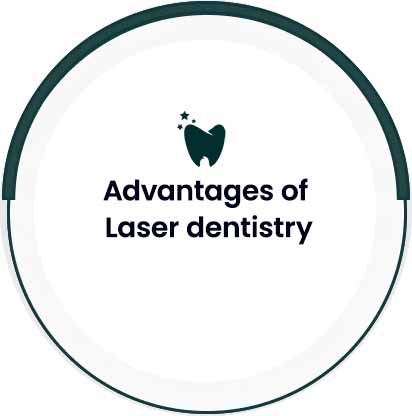
What is Laser Dentistry?
Laser refers to light amplification by stimulated emission of radiation. In dental applications, lasers can shape, cut, and remove dental tissues.
Common lasers used in dentistry

Hard tissue lasers :
These lasers are designed to shape and cut hard dental tissues such as bones and teeth. They are also used for certain dental procedures like removing old fillings, addressing tooth sensitivity, and preparation of cavities.

Soft tissue lasers :
These lasers target the soft tissues present in the oral cavity, including the cheeks, palate, tongue, and gums. They are often used for some procedures like removing excess tissue, treating gum disease, and gum reshaping.
Signs that indicate the need for Laser Dentistry

Gum Disease (Periodontal Disease) :
⦿ Signs : Swollen, bleeding gums, gum recession, pocket formation between teeth and gums, bad breath, and loose teeth.
⦿ Laser Dentistry Application : Lasers can be used to remove infected or inflamed gum tissue, clean out bacteria from pockets, and promote gum tissue reattachment to teeth in periodontal therapy.

Canker Sores and Lesions :
⦿ Laser Dentistry Application : Lasers can help in the painless and quick removal of canker sores and oral lesions.

Tooth Sensitivity :
⦿ Laser Dentistry Application : Hard tissue lasers can be used to seal and desensitize exposed dentin, reducing tooth sensitivity.

Gum Contouring :
⦿ Signs : An uneven gum line, excessive gum tissue, or a “gummy smile” that affects the aesthetics of the smile.
⦿ Laser Dentistry Application : Soft tissue lasers can reshape the gumline and improve the smile’s appearance by removing excess gum tissue.

Dental Fillings :
⦿ Signs : The need for fillings due to cavities or tooth decay.
⦿ Laser Dentistry Application : Hard tissue lasers can prepare the tooth for a filling by precisely removing decayed tissue, often without the need for local anaesthesia.

Teeth Whitening :
⦿ Signs : Desire for a brighter and whiter smile.
⦿ Laser Dentistry Application : Lasers can enhance the effectiveness of teeth whitening procedures by activating and accelerating the bleaching agents.

Biopsies :
⦿ Laser Dentistry Application : Lasers can assist in performing biopsies by safely removing a small piece of tissue for laboratory analysis.

Root Canal Treatment :
⦿ Laser Dentistry Application : Lasers can be used to disinfect and shape root canals during endodontic procedures, potentially improving treatment outcomes.

Frenectomy :
⦿ Laser Dentistry Application : Lasers can precisely and safely remove or modify the frenulum to improve tongue and lip mobility.

Excess Tissue Removal :
⦿ Signs : Overgrown or excess tissue that needs to be removed for various reasons.
⦿ Laser Dentistry Application : Soft and hard tissue lasers can be used to remove excess tissue efficiently and with minimal discomfort.


Precision and Accuracy

Minimised Discomfort and Pain
Laser procedures are often associated with minimal discomfort and pain compared to traditional dental techniques. This may reduce the need for anaesthesia or post-operative pain management.

Reduced Bleeding and Swelling
Lasers cauterise blood vessels and promote immediate blood clotting, resulting in less bleeding during and after procedures. This leads to reduced swelling and a more comfortable recovery period.

Faster Healing and Recovery
Laser energy promotes faster healing by stimulating tissue regeneration and reducing the risk of infection. Patients often experience quicker recovery times after laser-based procedures.

Enhanced Aesthetics
Laser dentistry allows for precise gum reshaping and contouring, enhancing the aesthetics of the smile by improving the gums’ appearance and overall dental alignment.
